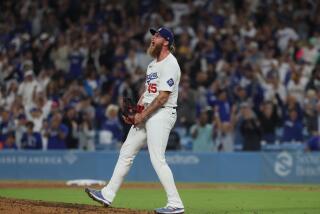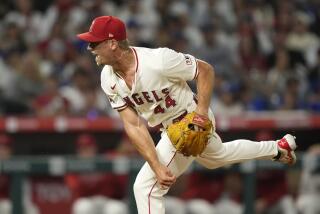Keeping the change
- Share via
Francisco Rodriguez has taken his changeup from the laboratory to the field. What was once an experimental pitch, one he rarely threw without a safety net, has been fully integrated into his repertoire this season, giving the Angels’ closer yet another weapon to attack hitters with.
As if he needed it. Rodriguez, who is 1-2 with a 2.30 earned-run average and an American League-leading 22 saves entering tonight’s game against Pittsburgh, already is armed with one of baseball’s most devastating sliders, and when he’s locating his 95-mph fastball, it’s an exceptional pitch.
And now, a changeup? Who is this guy, the Rambo of relievers?
“I don’t think I’ve seen anyone get a hit off of it,” Angels designated hitter Shea Hillenbrand said. “Guys either swing through it, foul it off or take it. They’re more or less baffled, because they’re looking for the breaking ball or fastball. If he throws the changeup with good location, it’s awesome, because you don’t see many closers with three dominant pitches.”
Gary Matthews Jr. has one hit in eight at-bats against Rodriguez, and in his three years at Texas from 2004 to 2006 the center fielder said Rodriguez “never used the changeup.”
But Matthews noticed the 25-year-old right-hander working on the pitch in spring training, and he has noticed the funny swings and looks from opposing hitters -- such as Ken Griffey Jr. last week in Cincinnati -- Rodriguez has gotten this season.
“No matter what point you’re at in this game, you have to come up with new tricks, because the game is all about adjustments,” Matthews said. “He still knows what his strengths are, but there’s definitely nothing wrong with developing other pitches and having a more complete game to give hitters something else to think about.”
Much like former Angels closer Troy Percival, who tried for years, with marginal success, to develop a third pitch, Rodriguez worked on his changeup diligently in spring training, only to essentially scrap it in the regular season.
On the rare times he threw it, he was usually ahead in the count with a lead of two or three runs or more. With the game on the line, few closers want to get beat with their second or third pitch.
But earlier this season, Rodriguez threw two straight changeups to Oakland outfielder Milton Bradley, who swung at and missed both. Rodriguez began to think of his changeup more as an out-pitch than a show-me pitch.
On the last trip, he struck out St. Louis Cardinals slugger Albert Pujols with a changeup, got Griffey to swing and miss at a floater that pitching coach Mike Butcher called “a Bugs Bunny changeup,” and struck out Dodgers outfielder Andre Ethier with a change.
“That’s the only way I’m going to get confident in the pitch, by throwing it when people don’t expect it,” said Rodriguez, who has 46 strikeouts and 12 walks in 31 1/3 innings and has held opponents to a .212 average.
“I’ve been throwing it a lot, mostly to left-handers. They’re looking for the slider or the fastball; they’re not looking for the changeup. They think it’s a fastball, they jump at it, and they’re out in front of the pitch.”
Still, Rodriguez wouldn’t compare his changeup to that of Trevor Hoffman or Eric Gagne in his prime. On a scale of one to 10, with 10 being best, Rodriguez rated his changeup “a four or five” because he hasn’t been consistent with his location.
“The times I’ve used it, it’s been working,” said Rodriguez, who has converted 22 of 23 save opportunities this season and 114 of 124 since becoming a full-time closer in 2005. “But I’m not going to be as confident in that pitch as I am in the slider.”
Well, yeah. Rodriguez may have baseball’s best slider, a pitch he can throw like a slow curve, starting it high and dropping it into the strike zone, or a nasty snap hook, starting it in the zone and making it dive into the dirt. In a tense situation, Rodriguez will almost always lean on his best pitch. But the more success he has with the changeup, the more confident he will become in it. And the more he uses it in tight spots, the more hitters will have to brace themselves for it.
“I think it’s a plus pitch for him, especially when you have the fastball and breaking ball hitters have to be aware of,” Butcher said. “You can tell by the swings that it’s an effective pitch.”
More to Read
Go beyond the scoreboard
Get the latest on L.A.'s teams in the daily Sports Report newsletter.
You may occasionally receive promotional content from the Los Angeles Times.







